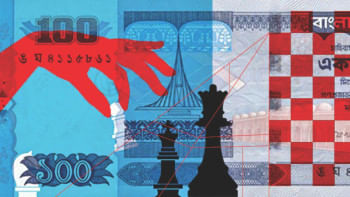What is the future of Bangladesh’s debt-ridden macroeconomy?

Bangladesh's internal and external debt seem to be skyrocketing. As the grace period for the megaprojects is nearing the end, foreign debt services are rising at an alarming rate. Moreover, the country is taking loans from the banking system. Being criticised for excessive debt from commercial banks, the government is now taking loans from the central bank, which in a sense is printing new money. This injection of new money into the economy is adding to the high inflation. So, we need to ask this now: what is the future of Bangladesh's debt-ridden economy?
The burden of rising debt
Data obtained from the Bangladesh Bank shows that the country's total external debt increased to nearly $96.25 billion at the end of December 2022 – of which $71.9 billion belong to the government, and the rest to the private sector. In just 10 years, the country's outstanding foreign debt more than tripled, says a World Bank report.
In FY17, Bangladesh's debt service on external debt was $2.28 billion, which rose to $5.69 billion in FY21, according to the World Bank. In just four years, it grew 2.5 times. The official narrative says the debt-GDP ratio is still within the tolerable limit. But the fact is Bangladesh's GDP data is questionable – in recent years, the GDP data has been inflated by just changing the base year. Moreover, the country does not adjust inflation and deflation of the taka against the US dollar. According to the Bangladesh Bureau of Statistics (BBS), the country's per capita income fell one percent year-on-year to $2,765 in 2022-23. This is absurd, as the taka devalued at least by 21 percent in just one year. Moreover, while a recently released World Bank report says food prices have increased by 33 percent in one year in Bangladesh, the BBS still shows just nine percent inflation. Hence, there are significant doubt and concerns about the integrity of the country's official data.
For example, taking the 21 percent devaluation of the taka into consideration, the 11.36 percent inflation (Sanem data) and a growth of 6.1 percent (World Bank projection) put the real GDP size at $339 billion, not $460 billion. The current inflation in Bangladesh may actually be much higher than official projections, so the real GDP would be even lower. Meanwhile, the government has taken new loans from the IMF, World Bank, Jica, ADB, etc. Moreover, the deferred LCs of commercial banks turned into an additional burden of short-term debts. Overall, in my estimate, the total foreign debt position of the country may have crossed 30 percent of the GDP – beyond the safe limit of 25 percent. Together with internal loans, the total debt-GDP ratio would then exceed 50 percent.
In the past two years, Bangladesh's foreign debt has increased more than $27 billion. While Pakistan's external debt has increased by 114 percent and Sri Lanka's by 61 percent in a decade, Bangladesh's external debt has increased by 227 percent. Bangladesh is definitely on the risky path of foreign debt.
The government is also suffering from a severe shortage of money. In April, the government borrowed a record amount of Tk 29,697 crore from banks in the current fiscal year. In addition to this, there are significant external debts. According to the Bangladesh Bank data, between July and April, the government borrowed a total of Tk 82,057 crore from the banking system, of which the central bank provided around 80 percent. If you ask economists, they will readily admit that this is new money injection. This is simply alarming. According to the central bank, the government borrowed a total of Tk 3.56 lakh crore from the country's banking accounts by April. Of that amount, Tk 2.22 lakh crore were borrowed from commercial banks.
To secure the country's economic future, the government must reduce its operational expenses and control corruption, adopt prudent fiscal and monetary policies, diversify the economy, diversify export, secure new and skilled manpower markets abroad, attract foreign investment, and, last but not the least, ensure efficient utilisation of borrowed funds. Only an accountable administration and a representative democracy can facilitate that. It is imperative to strike a balance between the need for infrastructure development and the sustainable management of debt to safeguard long-term economic stability and prosperity for the people of Bangladesh.
This practice can strain the banking system and hinder its ability to support private sector lending, which is crucial for sustainable economic growth. Furthermore, the need to borrow from the central bank to cover the financing gap raises concerns about the creation of new money, leading to inflationary pressures.
These escalating debt levels pose serious risks to Bangladesh's economic stability and growth prospects. Rapidly increasing external debt service payments indicate that a substantial portion of the country's foreign currency earnings is diverted towards servicing existing obligations. This trend can strain the balance of payments and reduce available resources for vital sectors like healthcare, education, and infrastructure development.
One of the primary drivers of the mounting debt burden is the completion of megaprojects, power and energy sector debts, dues and the capacity charge payments, which were initiated to stimulate economic growth and enhance infrastructure. While some of these projects may have long-term benefits, the immediate debt servicing requirements are challenging the government's financial capacity.
Inflationary pressures and economic consequences
The injection of new money via borrowing from the central bank is adding to the inflationary pressure in Bangladesh. As the money supply expands without a corresponding increase in production and output, the excessive liquidity can further drive up prices and erode the purchasing power of the local currency. High inflation can hinder economic stability, deter foreign investment, and create hardships for the general population, particularly low-income individuals and vulnerable groups.
The government should prioritise efficient utilisation of borrowed funds to ensure maximum returns on investment. Implementing robust project management frameworks, promoting transparency and accountability, and reducing corruption can help optimise the benefits of megaprojects while minimising financial risks. Enhancing tax compliance, broadening the tax base, increasing FDI, and reducing tax evasion in favour of rich people can provide sustainable revenue streams to finance public expenditure and reduce the need for excessive borrowing. Moreover, the government must improve its public and fiscal data integrity.
To secure the country's economic future, the government must reduce its operational expenses and control corruption, adopt prudent fiscal and monetary policies, diversify the economy, diversify export, secure new and skilled manpower markets abroad, attract foreign investment, and, last but not the least, ensure efficient utilisation of borrowed funds. Only an accountable administration and a representative democracy can facilitate that. It is imperative to strike a balance between the need for infrastructure development and the sustainable management of debt to safeguard long-term economic stability and prosperity for the people of Bangladesh.
Faiz Ahmad Taiyeb is a Bangladeshi columnist and writer living in the Netherlands. Among other titles, he has authored Fourth Industrial Revolution and Bangladesh and 50 Years of Bangladesh Economy.

 For all latest news, follow The Daily Star's Google News channel.
For all latest news, follow The Daily Star's Google News channel. 









Comments